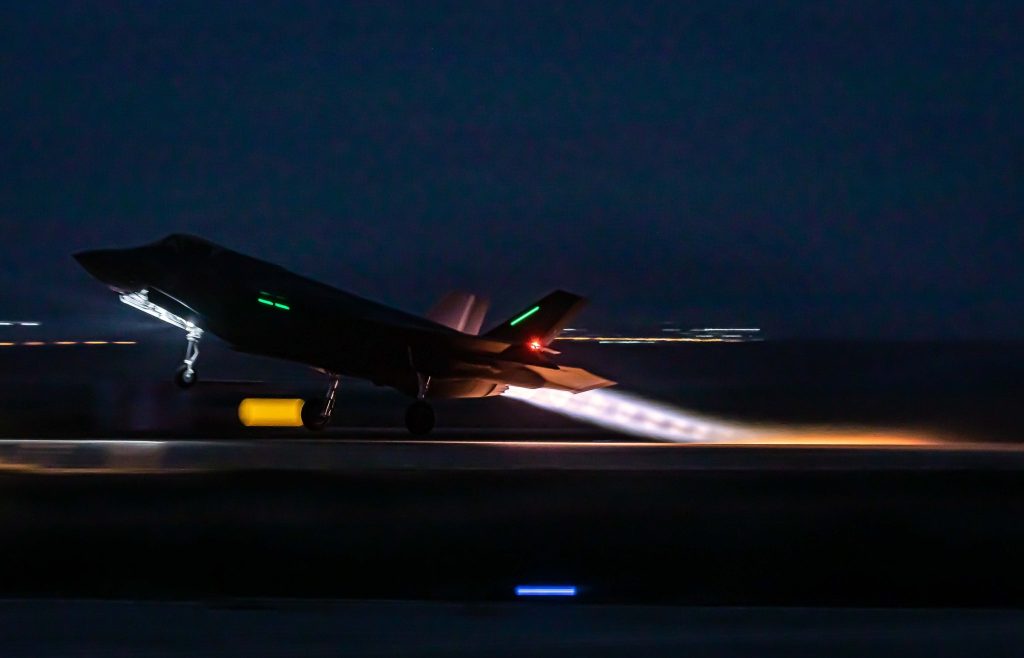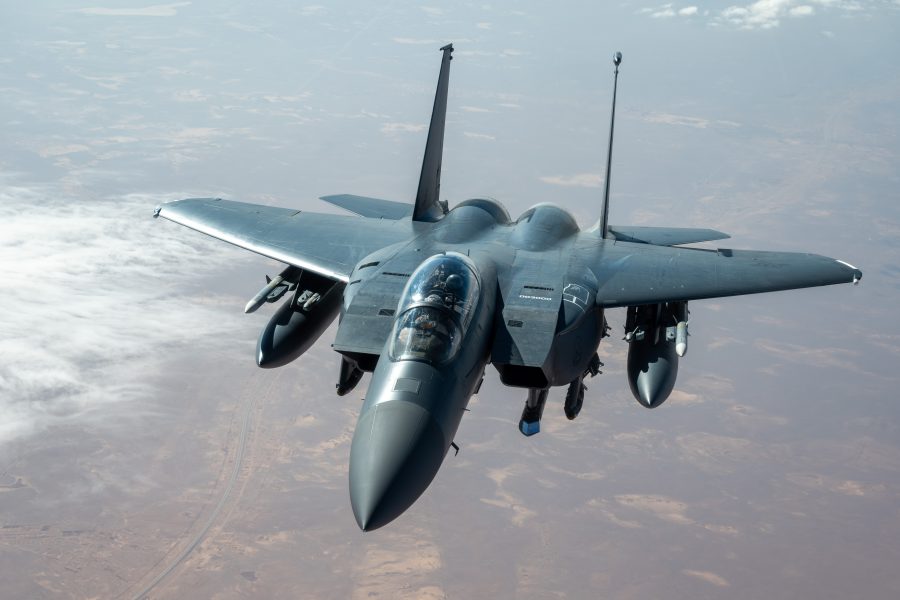U.S. Air Force F-15E Strike Eagles and F-16 Fighting Falcons shot down dozens of Iranian drones as they were heading toward targets in Israel on April 13, a U.S. official told Air & Space Forces Magazine.
On April 14, U.S. officials singled out the role of F-15E Strike Eagles from the 494th Fighter Squadron and the 335th Fighter Squadron in downing more than 70 Iranian drones. But on April 15, a U.S. official noted that F-16s were involved in the shoot-downs as well.
The F-16’s involvement in blunting Iran’s attack on Israel has not been previously reported.
A Patriot battery in Erbil, Iraq, took down a ballistic missile, and the USS Arleigh Burke and USS Carney in the Eastern Mediterranean took down four to six ballistic missiles, the officials added. U.S. Navy aircraft also supported the mission.
President Joe Biden spoke with members of the F-15 squadrons to “commend them for their exceptional airmanship and skill in defending Israel from an unprecedented aerial attack by Iran,” the White House said.
U.S. officials said the Iranian attack consisted of more than 100 ballistic missiles, 30 land-attack cruise missiles, and 150 drones. The U.S. said it intercepted missiles and drones en route to Israel, launched from Iran, Iraq, Syria, and Yemen. U.S. and Israeli officials said that “99 percent” of the drones and missiles were intercepted. The majority were taken out by Israel, a senior U.S. official said. British and French fighters also took down some drones.
“The close cooperation between the U.S. military and the IDF has led to the formation of a strong coalition that proved itself last night in the face of Iran’s aerial attack,” the IDF said in an April 14 statement.
While Israel mounted its defense with Arrow 2 and Arrow 3 surface-to-air interceptors and fighters, the U.S. coordinated the air defense for the coalition forces at the Combined Air Operations Center at Al Udeid Air Base, Qatar, where Air Forces Central (AFCENT) boss Lt. Gen. Alexus G. Grynkewich serves as the regional air defense commander.
Biden ordered the movement of extra F-15s and destroyers—which carry the highly-capable AEGIS air defense system—to the region in the past week. In a statement on April 13, Biden said those deployments led to “nearly all” of the incoming drones and missiles being intercepted. A senior administration official told reporters that over 100 ballistic missiles were airborne at the same time during the attack.
In an interview with Air & Space Forces Magazine on April 14, Grynkewich declined to discuss Iran’s attack. However, Grynkewich described how the CAOC typically coordinates air defense.
“We take whatever assets we have that are in theater … under our tactical control or in a direct support role across the joint force and the coalition, and we stitch them together so that we can synchronize the fires and effects when we get into that air defense fight,” Grynkewich said.
In the future, the U.S. wants to increase collaboration in air and missile defense, which has been a long-standing goal for CENTCOM.
“There has been a lot that’s been accomplished” in recent years, Grynkewich said. “We’re trying to stitch together partners in the region who share a perspective of a threat, share concern of the threats to stability in the region—which primarily emanate from Iran with a large number of ballistic missiles—and be in a position where we’re able to share information, share threat warning. And the ultimate goal is to get to a much deeper and fuller integration. We’ve made tremendous progress.”
British Prime Minister Rishi Sunak said RAF jets shot down “a number” of Iranian drones during the barrage. The U.K. Defense Ministry said in a statement that Royal Air Force aircraft in the region were prepared to “intercept any airborne attacks within range of our existing missions.” Additional RAF fighter jets and refueling tankers have been deployed for the counter-Islamic State mission in Iraq and Syria, which has also freed up U.S. air assets to focus on intercepting Iranian threats.
“It’s a win for the concept of integrated air and missile defense across the theater,” retired Marine Corps Gen. Kenneth F. McKenzie, the CENTCOM commander from 2019-2022, told Air & Space Forces Magazine. “People should draw strong conclusions from what just happened about the efficacy of that approach.”
Other former top Middle East generals agreed.
“One of the big concerns we had was how we were going to share the air picture with the Israelis and then coordinate who was doing what when the shooting started,” added retired Air Force Gen. Jeffrey L. Harrigian, the commander of AFCENT from 2016-2018. “Based on the results, it sounds like it was pretty good coordination.”
CENTCOM’s commander from 2016-2019, retired Army Gen. Joseph L. Votel, said Iran’s attack proved integrated air and missile defense “ought to now be an overriding priority” for the entire region.
“I hope the Gulf states are taking note of this,” Votel said. “The level of cooperation between Western militaries plus Jordan is a real example that they should be eager to emulate against the Iranian threat.”
Iran said its drone and missile strikes—its first direct attack against Israeli territory—were in response to an April 1 attack by Israel that killed senior figures in the Islamic Revolutionary Guard Corps at a facility in Damascus. Iran vowed retaliation and Israel, the U.S., and the region were bracing for the attack. It is unclear how Israel will respond.
Biden spoke by phone with Israeli Prime Minister Benjamin Netanyahu after the attacks. A senior administration official told reporters the two leaders “had a discussion about trying to slow things down.”
“This is a big deterrent failure for the Iranians,” said Michael Knights of the Washington Institute for Near East Policy. “That’s the key takeaway from this. But it’s also a moment when I think the Israelis would be under a lot of pressure now to just let the volume go down on this conflict.”

